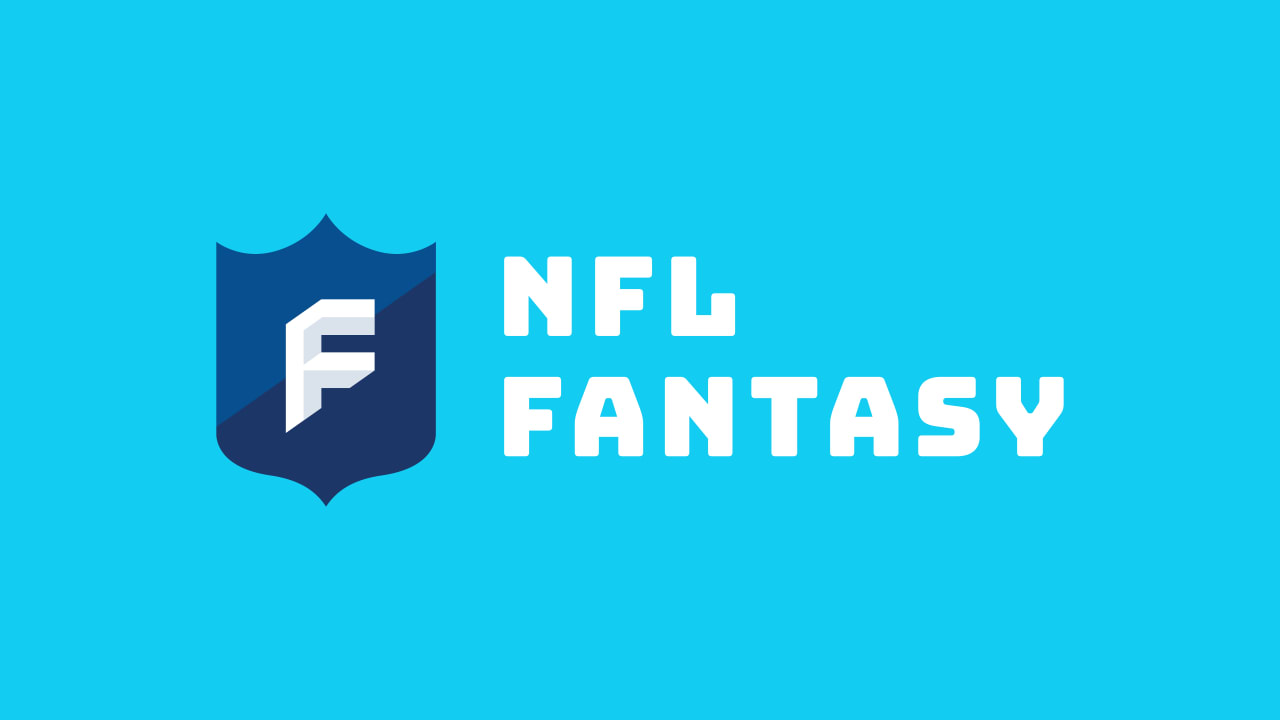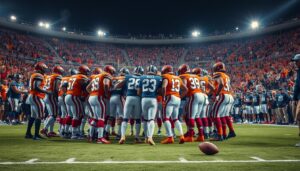Fantasy NFL Football is a virtual game where participants build teams using real NFL players. Points are scored based on player performances.
Fantasy NFL Football offers fans a chance to engage more deeply with the sport. By drafting and managing their own teams, participants experience the thrill of competition. Real NFL player performances determine the scoring, making each game exciting. The strategic elements of drafting and trade decisions add layers of complexity and enjoyment.
Fantasy football leagues foster camaraderie and friendly rivalry among friends and colleagues. The game has grown in popularity due to its interactive nature and the sense of ownership it provides. It’s an excellent way for fans to test their football knowledge and stay connected to the NFL season.
Getting Started
Fantasy NFL Football offers excitement and competition. Getting started can seem daunting, but with the right steps, you’ll be on your way to building a winning team. This guide will help you navigate the initial stages of your fantasy football journey.
Choosing A League
Choosing the right league is crucial. Leagues come in various formats, each with its own rules and settings. Here are some common types:
- Standard Leagues: These have basic scoring and roster settings.
- PPR (Points Per Reception) Leagues: Players earn points for catches, making wide receivers and tight ends more valuable.
- Dynasty Leagues: You keep most or all of your players from year to year, emphasizing long-term strategy.
- Keeper Leagues: You can retain a few players each season, balancing short-term and long-term planning.
Consider these factors when choosing a league:
- Competition Level: Are you a beginner or experienced?
- Draft Type: Do you prefer a live draft or an auto draft?
- Entry Fees: Some leagues have fees; others are free.
- League Size: More teams mean a deeper player pool and more strategy.
Discuss with your friends or online communities to find a league that matches your interests and skill level.
Draft Preparation
Preparation is key to a successful draft. Start by researching player rankings and projections. Look for expert opinions and consensus rankings. Here’s a step-by-step guide:
- Research: Gather information on player stats, injuries, and team changes.
- Mock Drafts: Participate in mock drafts to practice and test strategies.
- Create Tiers: Group players into tiers based on their value. This helps make quick decisions during the draft.
- Draft Strategy: Decide if you’ll go for a balanced team, running back-heavy, or wide receiver-heavy approach.
- Stay Updated: Keep an eye on the latest news and updates, especially close to draft day.
Here’s a sample table of key positions to target in the early rounds:
| Round | Position |
|---|---|
| 1-2 | Running Back |
| 3-4 | Wide Receiver |
| 5-6 | Quarterback |
| 7-8 | Tight End |
Preparation ensures you make informed choices. Stay flexible and adapt to the draft’s flow.

Credit: open.spotify.com
Draft Strategies
Fantasy NFL Football is a thrilling experience that allows fans to build their dream team. The key to success lies in your draft strategies. Knowing the right moves can make or break your season. Let’s dive into some essential tips and tricks to help you dominate your league.
Player Rankings
Understanding player rankings is crucial. Rankings help you identify the best players for your team. These rankings are based on past performances, current form, and potential.
When studying player rankings, consider these factors:
- Consistency: Players who perform well every week are valuable.
- Injury History: Avoid players prone to injuries.
- Team Offense: Players in high-scoring teams are more likely to score points.
Here is a table of top-ranked players:
| Rank | Player | Team | Position |
|---|---|---|---|
| 1 | Patrick Mahomes | Kansas City Chiefs | QB |
| 2 | Christian McCaffrey | San Francisco 49ers | RB |
| 3 | Davante Adams | Las Vegas Raiders | WR |
Use these rankings to guide your picks. Also, keep an eye on updates and injuries throughout the season.
Mock Drafts
Mock drafts are practice drafts that help you prepare for the real thing. They simulate the drafting process and give you a feel for what to expect.
Benefits of doing mock drafts:
- Strategy Testing: Try different strategies without real consequences.
- ADP Understanding: Learn the average draft positions of players.
- Confidence Building: Gain confidence in your choices.
Follow these steps for effective mock drafting:
- Choose a platform that offers mock drafts.
- Select a draft format similar to your league.
- Participate in multiple mock drafts.
- Analyze your performance and adjust your strategies.
Mock drafts are an excellent way to refine your approach. They help you make informed decisions during the actual draft.
Building A Team
Fantasy NFL Football is an exciting way to engage with the sport. Building a winning team requires strategy and insight. This blog post will help you understand the best approach to assembling your fantasy squad.
Position Priorities
When building your fantasy NFL team, understanding position priorities is key. Each position has a different impact on your overall score. Here’s a breakdown:
- Quarterbacks (QB): They are the backbone of your team. A high-performing QB can give you consistent points.
- Running Backs (RB): These players can rack up points quickly. Look for those who are also involved in the passing game.
- Wide Receivers (WR): Top-tier WRs can be game-changers. They often score big during the season.
- Tight Ends (TE): A versatile TE can offer both blocking and receiving points, adding value to your team.
- Kickers (K): Often overlooked, but a reliable kicker can be the difference in close matchups.
- Defense/Special Teams (DST): A strong defensive unit can score points through sacks, interceptions, and special teams plays.
Consider drafting based on the following table:
| Round | Position to Target |
|---|---|
| 1st-2nd | RB, WR |
| 3rd-4th | QB, WR |
| 5th-6th | RB, TE |
| 7th-8th | WR, RB |
| 9th+ | K, DST |
Balancing Stars And Sleepers
Balancing stars and sleepers is crucial for a successful fantasy team. Stars are the proven performers. They provide a solid foundation. Sleepers are less obvious picks. They have the potential to outperform expectations.
Here’s how to balance your team:
- Draft Stars Early: Use early picks on reliable stars. These players will be the core of your team.
- Identify Sleepers: Research players who have the potential for breakout seasons. These can be rookies or players in new roles.
- Monitor Injuries: Stay updated on player injuries. This can affect both stars and sleepers.
- Use Waiver Wire: Keep an eye on the waiver wire. It’s a great place to find emerging sleepers.
Consider the following mix:
| Player Type | Number of Players |
|---|---|
| Stars | 5-6 |
| Sleepers | 4-5 |
| Reliable Veterans | 3-4 |
Finding the right balance between stars and sleepers will give you a competitive edge. Happy drafting!

Credit: fantasy.nfl.com
In-season Management
Fantasy NFL Football is an exciting way to engage with the NFL season. In-Season Management is crucial for achieving success in your fantasy league. Keeping your team competitive requires constant attention, smart decisions, and strategic moves. This section dives into key areas such as Waiver Wire Tactics and Trade Negotiations to help you dominate your league.
Waiver Wire Tactics
Managing the waiver wire is essential for keeping your fantasy team strong. Players often get injured, and new stars emerge. Here are some tactics to help you navigate the waiver wire:
- Prioritize Your Needs: Identify the positions where you need the most help.
- Stay Informed: Follow NFL news and updates. This helps you spot emerging players.
- Check Matchups: Look at the upcoming schedules. Pick players with favorable matchups.
Using the waiver wire effectively can make or break your season. Consider these tips:
| Tactic | Description |
|---|---|
| Handcuffing | Pick up the backup for your star players. |
| Streaming | Rotate players based on weekly matchups. |
| Early Bids | Submit waiver claims early to get the best players. |
Consistency is key. Monitor the waiver wire every week. Flexibility and quick decisions will keep your team ahead of the competition.
Trade Negotiations
Trades are another crucial aspect of in-season management. Smart trades can turn a good team into a great one. Here are some strategies for successful trade negotiations:
- Know Your Team’s Needs: Identify weak spots in your lineup.
- Research Other Teams: Find out what other teams need. This helps you offer valuable trades.
- Be Fair: Offer trades that benefit both sides. This increases the chances of acceptance.
Effective trade negotiations often involve multiple steps:
- Initiate Contact: Reach out to potential trade partners.
- Present Your Offer: Make a clear and fair proposal.
- Negotiate: Be prepared to adjust your offer.
Here’s a simple table to understand trade value:
| Player Type | Trade Value |
|---|---|
| Star Player | High |
| Injured Player | Low |
| Emerging Player | Medium |
Communication is key. Be respectful and clear in your offers. Flexibility will help you find the best deals.
Scoring Systems
Fantasy NFL Football is an exciting way for fans to engage with the sport. A key aspect of the game is the scoring system, which determines how players earn points. Understanding these systems is crucial for success in your fantasy league. This blog post will delve into the different scoring systems and how points are allocated.
Standard Vs. Ppr
In Fantasy NFL Football, two main scoring systems are used: Standard and PPR (Points Per Reception). Each system has its unique way of awarding points:
- Standard Scoring: This is the traditional method. Players earn points based on their yardage and touchdowns.
- PPR Scoring: In this system, players also earn points for each reception. This can significantly impact a player’s value, especially for wide receivers and tight ends.
Here is a comparison of the two:
| Action | Standard Points | PPR Points |
|---|---|---|
| Rushing/Receiving Yard | 0.1 points | 0.1 points |
| Touchdown | 6 points | 6 points |
| Reception | 0 points | 1 point |
PPR leagues tend to favor players who catch more passes. Running backs who are heavily involved in the passing game see a boost in value. For example, a player like Christian McCaffrey would be more valuable in a PPR league.
Understanding Points Allocation
Knowing how points are allocated helps you make better decisions. Here are the common ways points are awarded in fantasy football:
- Passing: Quarterbacks earn points for passing yards and touchdowns. Each yard might be worth 0.04 points, and touchdowns are often worth 4 points.
- Rushing/Receiving: Running backs, wide receivers, and tight ends earn points for rushing and receiving yards. Touchdowns generally add 6 points.
- Receptions: In PPR leagues, each reception adds 1 point. This rewards players who catch many passes, even if they don’t gain many yards.
Here is a detailed points allocation table:
| Action | Points |
|---|---|
| Passing Yard | 0.04 points |
| Passing Touchdown | 4 points |
| Rushing/Receiving Yard | 0.1 points |
| Rushing/Receiving Touchdown | 6 points |
| Reception (PPR only) | 1 point |
Understanding these allocations helps you draft players more effectively. Quarterbacks who throw many touchdowns are valuable. Running backs who catch passes are crucial in PPR leagues. With this knowledge, you can tailor your team to your scoring system and maximize your points.

Credit: www.nfl.com
Player Analysis
Fantasy NFL Football is a thrilling game that allows fans to become team managers. One crucial aspect of playing Fantasy NFL Football is Player Analysis. Knowing how to analyze players can be the difference between winning and losing. This section will dive into two essential aspects of player analysis: Injury Reports and Matchup Considerations.
Injury Reports
Injury reports are a critical factor in Fantasy NFL Football. Players can get injured anytime, affecting your team’s performance. It’s vital to stay updated on the latest injury news.
Here are some key points to consider:
- Recent Injuries: Always check the latest injury reports. A player may be ruled out for the week.
- Severity of Injury: Determine if the injury is minor or major. Minor injuries might not affect performance much.
- Recovery Time: Know how long a player will be out. This helps in planning your lineup.
- Backup Players: Identify potential backups. They may have a chance to perform well in the injured player’s absence.
Consider the following table for recent injury updates:
| Player | Injury | Status | Expected Return |
|---|---|---|---|
| John Doe | Hamstring | Questionable | 2 weeks |
| Jane Smith | Concussion | Out | 1 week |
| Michael Johnson | ACL Tear | Out | Season |
Matchup Considerations
Matchup considerations are crucial for setting your Fantasy NFL Football lineup. Different teams have varying strengths and weaknesses.
Pay attention to these factors:
- Team Defense: Some teams have strong defenses. Avoid starting offensive players against them.
- Weather Conditions: Weather can impact gameplay. Rain or snow can affect a player’s performance.
- Home vs. Away Games: Players often perform better at home. Take this into account when setting your lineup.
- Historical Performance: Look at how players have performed against specific teams in the past.
Here is a table showing favorable and unfavorable matchups:
| Player | Opponent | Matchup Type |
|---|---|---|
| Aaron Rodgers | Chicago Bears | Unfavorable |
| Dalvin Cook | Detroit Lions | Favorable |
| DeAndre Hopkins | Seattle Seahawks | Neutral |
Considering these factors will help you make informed decisions. This can boost your chances of winning in Fantasy NFL Football.
Fantasy Playoffs
Fantasy NFL Football brings excitement and competition to fans. The Fantasy Playoffs are the pinnacle of this thrill. This period determines the true champions. Preparing well and making smart decisions are key. Let’s dive into some strategies to dominate the Fantasy Playoffs.
Setting Up For Success
Proper setup is crucial for a strong playoff run. Follow these steps to position yourself for victory:
- Analyze Matchups: Study the schedules of your key players. Favorable matchups can lead to high scores.
- Plan Ahead: Look at the playoff weeks. Make sure your top players have good matchups during these weeks.
- Depth Matters: Injuries can strike anytime. Ensure your bench has capable backups.
Use a table to track your players’ matchups:
| Player | Week 14 | Week 15 | Week 16 |
|---|---|---|---|
| Player A | Favorable | Neutral | Unfavorable |
| Player B | Unfavorable | Favorable | Neutral |
Stay Updated: Keep an eye on injury reports and team news. This helps in making timely adjustments.
Utilize Waivers: Scout the waiver wire for any potential breakout players. They can be game-changers.
Managing Roster Moves
Managing your roster is essential for playoff success. Be proactive and strategic with your moves:
- Monitor Injuries: Replace injured players quickly. This keeps your team competitive.
- Handcuff Strategy: Secure backups for your star players. This protects you from sudden injuries.
- Flexibility: Keep players with multi-position eligibility. This offers more lineup options.
Here are some tips for effective roster management:
- Trade Wisely: Make trades that strengthen your team for the playoffs. Avoid trading just to trade.
- Weekly Adjustments: Set your lineup based on the latest information. Be ready to make last-minute changes.
- Bench Utilization: Use your bench spots for high-upside players. Avoid holding onto non-performers.
Use a simple checklist for roster management:
- Check injury reports
- Monitor waiver wire
- Adjust lineup weekly
- Evaluate trade offers
Stay vigilant and make smart decisions. Your efforts will pay off during the Fantasy Playoffs.
Community And Resources
Fantasy NFL Football brings fans together from all over the world. The game isn’t just about picking players and scoring points; it’s also about being part of a thriving community. There are countless resources available to help you succeed in your fantasy league. From online forums to specialized tools and apps, you have all you need to dominate your competition.
Online Forums
Online forums are a great way to connect with other Fantasy NFL Football enthusiasts. These platforms offer a wealth of knowledge and strategies. They are perfect for both beginners and seasoned players.
Key Benefits of Online Forums:
- Expert Advice: Many forums have experienced players who share their strategies and tips.
- Community Support: You can ask questions and get answers from the community.
- Latest News: Stay updated on player injuries, trades, and other important news.
- Trade Discussions: Get opinions on potential trades and player value.
Popular forums include:
| Forum Name | Description |
|---|---|
| Reddit Fantasy Football | Large community with up-to-date discussions. |
| Fantasy Footballers | Expert analysis and community interaction. |
| 4for4 | Premium content and active forums. |
Fantasy Tools And Apps
Fantasy Tools and Apps are essential for managing your fantasy team. These tools help you make informed decisions and stay ahead of the competition.
Top Fantasy Tools and Apps:
- Draft Wizards: Get mock drafts and expert pick suggestions.
- FantasyPros: Comprehensive tools for rankings, projections, and analysis.
- Rotoworld: Player news and updates right at your fingertips.
- Fantasy Football Calculator: Accurate ADP data and draft strategies.
These tools offer:
- Real-Time Updates: Stay informed about player injuries and performance.
- Data Analysis: Access in-depth statistics and player comparisons.
- Customizable Rankings: Adjust rankings based on your league’s scoring system.
- Alerts and Notifications: Get instant updates on important events.
Using these tools can give you a significant edge in your fantasy league. They provide you with detailed insights and up-to-date information, making it easier to manage your team effectively.
Frequently Asked Questions
What Is Fantasy Nfl Football?
Fantasy NFL Football is a virtual game where players draft real NFL athletes to their teams. Points are scored based on athletes’ actual game performances. It’s a popular pastime among NFL fans.
How Do You Play Fantasy Nfl Football?
To play, join a league, draft NFL players, and set your weekly lineup. Points are earned based on players’ real-life stats. The goal is to outscore your opponents.
When Does Fantasy Nfl Football Season Start?
The Fantasy NFL Football season typically starts in early September. It coincides with the beginning of the NFL regular season. Drafts usually happen in late August.
What Are Fantasy Nfl Football Drafts?
Drafts are events where participants select NFL players for their fantasy teams. They can be live or online. Draft strategy is crucial for a successful season.
Conclusion
Fantasy NFL football offers excitement and strategic depth for fans. Engage with fellow enthusiasts and enhance your football knowledge. Choose your players wisely and track their performance. Enjoy the thrill and competitiveness of fantasy leagues. Dive into the world of fantasy NFL football and elevate your game experience today.




